For David Stotz, each meal is a time capsule, capturing the tastes and preferences of cultures and people from centuries past.
David Stotz is Senior Creative Director at Maui Jim’s world headquarters in Peoria. He returns daily to Randolph Terrace, the name bestowed on his early 20th-century home—which was once occupied by prominent Peorians David Henry Proctor and Emma Louise Klingel Proctor, and more recently, served as a bed and breakfast. Stotz, who is also a Master Gardener, has spent countless hours creating and caring for the remarkable gardens that surround the residence. Stepping through Randolph Terrace’s front door is a step back in time.
 On Sunday afternoons, the home is filled with more than just the sights of years past. Classical music plays lightly in the background and the smell of forgotten recipes fills the air—from the heartiest of peasant breads to the ambrosial food of the Victorian aristocracy. A trio of enthusiastic Japanese Chins greets newcomers at the door as Stotz, smiling, offers a glass of champagne and gestures towards the dining room. “Welcome to Sunday dinner!” he beckons.
On Sunday afternoons, the home is filled with more than just the sights of years past. Classical music plays lightly in the background and the smell of forgotten recipes fills the air—from the heartiest of peasant breads to the ambrosial food of the Victorian aristocracy. A trio of enthusiastic Japanese Chins greets newcomers at the door as Stotz, smiling, offers a glass of champagne and gestures towards the dining room. “Welcome to Sunday dinner!” he beckons.
In Grandma’s Kitchen
“I don’t have a memory without cooking,” Stotz explains, recalling his childhood in Kentucky. Every Sunday, his extended family would gather in his grandmother’s home for conversation, laughter and nourishment.
For many families, Sunday afternoons provide a time to gather and catch up with one another. In years past, businesses and shops were usually closed, leaving free time for food and the occasional nap. “It gave everybody the opportunity to know what everybody else was doing,” Stotz recalls. “Your parents would talk about stuff, and Grandma and Grandpa would catch up on the kids.”
But when his cousins ran off to play, Stotz preferred the company of his grandmother in the kitchen. Even as a toddler, he was never far from her side. “I guess I was a sous chef,” he laughs. “She taught me the appreciation of cooking.” While his grandmother came from an English background, she married into a German-American family that preferred the taste of Pennsylvania Dutch meals. “She wanted to learn how to cook their favorites,” he explains. “She was anti-processed food—she didn’t do TV dinners!” He has fond memories of walnut cookies and springerle (a type of German biscuit), roasts and Swiss steak—all made from scratch.
Stotz’s lifelong appreciation for good food begins here: in the years he spent cooking alongside his grandmother. Even after leaving home, he would return each week for Sunday dinner—which by then had expanded to several tables in the basement to make room for their growing families.
Eventually, Stotz embarked on a career path that led him far from his grandmother’s cooking. “It was one of the things I missed when I left,” he recalls. “I couldn’t afford to eat out, but I really appreciated good food.”
To satisfy his culinary longings, he purchased cookbooks to learn new recipes. “I would start on page one and cook everything… all of the way through,” he says. “No matter what it was.”
Recipes From Centuries Past
After years of working his way meticulously through cookbooks, Stotz knew how to cook. He had experimented with a variety of cuisines and was always challenging himself to try something new. While living in Los Angeles, he was granted an opportunity to stage at a Japanese restaurant—working alongside the chef as an unpaid apprentice—and he jumped at the chance.
“Japanese cooking is not just a recipe,” he notes. “It is how the vegetables are sliced, how the vegetables are prepared. There’s a lot of preparation for just the simplest dish—because it has to look right, as well as follow the recipes.” After two years, he says, he felt like he finally grasped the concepts.
The pleasure Stotz derives from learning new cuisines and techniques seems to drive him as much as his appreciation of good food. There is perhaps no better example of this than his experiments with recipes dating from centuries past. While watching Downton Abbey, which was showcased on the PBS program Masterpiece (formerly Masterpiece Theatre), he realized he had an opportunity to expand his repertoire in a rather unusual way. “In the early Downton Abbey episodes, they were always eating,” he explains, “always sitting down at the table.”
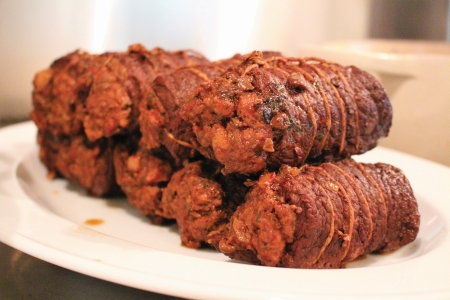
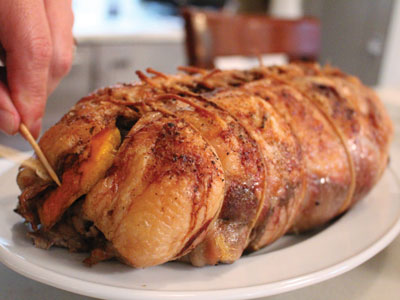
At left, beef olives. At right, Canard Ballotine stuffed with port-soaked figs, hazelnuts, sausage and farro.
Within a week, Stotz was creating dishes similar to those enjoyed on the show. The timing was perfect—it paired his love of Sunday dinners with a relaxing evening watching Masterpiece on WTVP. “You have an olfactory sense—some other thing happening while you’re watching the show,” he remarks of the pairing. Soon he began to create meals to accompany other Masterpiece shows, including Poldark, a British-American drama that takes place in the late 18th century, and Victoria, which depicts the early years of Queen Victoria’s reign.
Stotz researches each episode before it airs, scouring the web and his collection of cookbooks for period-appropriate recipes. To better understand a particular era, he alternates between food cooked by peasants and dishes created for the upper classes. The preparation can sometimes take more than a week. Not only must he prepare certain foods from scratch, the ingredients are often difficult to locate—and he insists on creating each recipe as he finds it.
In many ways, each meal is a time capsule, capturing the tastes and preferences of cultures and people far removed from the modern day. And he never tastes the food as he cooks, waiting instead for the moment when he joins everyone at the table. “Now that’s the fun part,” he exclaims. “I’m trying to experience it as everyone else is!”
The results can be surprising, often leaving guests momentarily speechless as they quietly absorb the tastes resulting from unusual ingredients and pairings. Stotz says he particularly enjoys cooking recipes alongside Poldark for this reason—the flavors can seem foreign to today’s palates. Taking place just after the American Revolutionary War, the recipes he recreates from this series date to the late 18th and early 19th centuries—and are sourced from even earlier recipes, many of them medieval.
“I think the 1700s are more interesting to me because the flavors are so different,” he explains. “They used a lot of clove, mace, cinnamon and black pepper. The flavors in 18th-century cooking can be very sharp.” Among his favorite dishes is a heavy, wintery meat stew called bukkenade, which dates to the 1500s. “It became a tavern dish,” Stotz notes, “and was a common dish that you would get when traveling.”
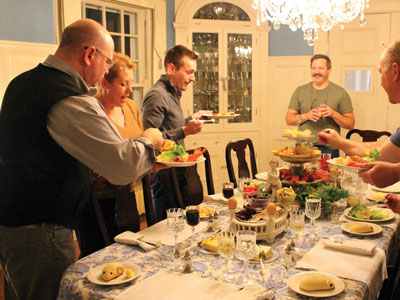
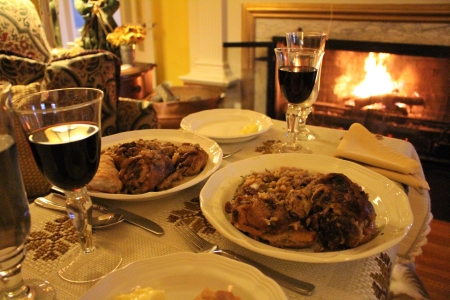
At left, guests gather at Randolph Terrace for Sunday dinner. On this day, Stotz made a salmagundi. “The object is to eat the centerpiece." At right, a fireside meal of peasant cassoulet.
To recreate these recipes requires some imagination, because unlike today, the ingredients were not precisely measured. “They say, add a bit of these, a bit of that and you do a bit of that,” he explains. “They call for things like ‘grass’… and if you don’t know anything about historic recipes, you think, What? Go grab a handful of my lawn? But what they really mean is a bouquet of whatever herbs you have available.”
Victorian cuisine, on the other hand, is more like today’s food. “There are interesting techniques in Victorian cooking that I really like, but the actual food doesn’t taste that different.” Still, he enjoys recreating the menus from Queen Victoria’s dinner parties, which have been meticulously preserved, he notes with a chuckle. “Victoria kept everything! So, you can look up recipes online from Holyroodhouse,” he says, referring to the royal palace in Edinburgh, Scotland, “and see the menus that she had while there.”
Unlike 18th-century meals, Victorian meals were presented in courses. “You’d get a fish dish, and then you’d get a vegetable, and then you’d get a meat,” he explains. “Rather than put your meat and potatoes on one plate, they would serve and eat each one separately.”
Stotz pays particular attention to the table setting—which he researches as much as the food itself. “I think the setting is important to the overall experience,” he remarks. “If you’re sitting down at a formal table where you have six forks and six knives and two spoons, you approach the meal very differently. It causes you to pause and take time to evaluate what you’re eating… What tool am I using? Does this make a difference?” Fish forks, for example, flake the meat of a fish far better than a salad fork, he says. “All of that stuff happens for a reason—and it changes the whole experience of eating.”
The Act of Gathering
For those wondering how much time it takes to cook one of Stotz’s Sunday dinners, his answer is simple: as long as you would like. “I think people today see cooking as a burden,” he muses. “They’ll say, Oh, that’s just too much work.” But when he isn’t recreating historic meals, Stotz will opt for far simpler recipes. “Pop a roast in the oven and it’s not a big deal,” he explains. “It’s the act of gathering that makes the Sunday dinner so fun.”
He encourages people to take risks with their cooking, telling stories of his own failures, which are often as interesting as the successes. When asked to recall a dish that was particularly bad, he always offers the same response: “Oh, the pilchards… that horrible thing!” In conjunction with a Poldark episode, Stotz created a traditional dish of pilchards (or sardines) and rarebit, a cheese sauce. To make it as authentic as possible, he had Spanish pilchards shipped to him, which arrived neatly packed in a box of ice.
“They’re crunchy,” he notes. “You’re supposed to eat the whole thing—you can feel the bones in your mouth. I went through so much work to do that dish… and for it to turn out so horrible… Oh well!” he shrugs.
The fear of failure, he believes, is the biggest mistake one can make in cooking. “It’s going to take you a long time to make dishes that are perfect every time,” he laughs, referencing a recent, failed attempt to recreate an 18th-century cranberry cake.
Another interesting aspect of Stotz’s journey through historic recipes has been discovering the origins of the food we enjoy today. Dishes like shepherd’s pie, hamburger and meatloaf are now standards, but their origins lie in the peasant classes. “Oddly enough… even though the upper crust was eating all of these really unique things, the flavors in the peasant food are actually the things that we now look for… Like cassoulet, a peasant dish, would be a very expensive dish in a fine restaurant now… but at the time it was peasant food.”
Ultimately, whatever its origins, a recipe has to be good to stand the test of time. “I think what a lot of people today don’t understand is eating is a sensory experience,” Stotz notes. “It’s not just something you do just to keep from dying! It’s something you need to enjoy.”
And as his guests begin to gather for Sunday dinner, it is clear that, for Stotz, food is more than an individual experience of the senses—it is a way to connect with people, just like he did as a child at his grandmother’s table. “It’s a human experience to sit and eat together,” he explains. “It’s a bonding experience.
“It’s a holiday every week,” he adds, pouring a friend another glass of wine. “And who doesn’t want a holiday every week?” a&s
Find more content related to this article on the PS Blog: "Chef's Notes: Recipes from the Past" and "Here We Come A-Wassailing"!
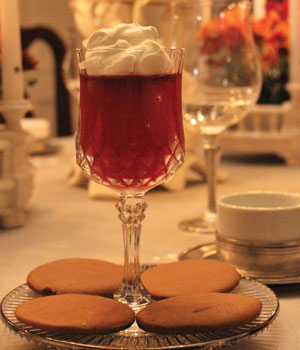 Port Wine Jelly: 18th-Century Dessert
Port Wine Jelly: 18th-Century Dessert
3 medium-size lemons
1tsp. cinnamon
¼ tsp. nutmeg (optional)
2 cups water
1 cup port wine
1 cup cold water
1 cup sugar
2 envelopes granulated gelatin (mixed into the cold water)
Using a vegetable peeler, take only the yellow rind off the lemons and place in a sauce pot. Next squeeze the juice while straining the seeds into same pot. Add the cinnamon (and nutmeg if desired) and 2 cups of water. Bring to a boil over medium heat, reduce to medium low and simmer for 5 minutes. Remove from heat, add the port and sugar, stir until dissolved, strain out the lemon peel, and bring the liquid to a simmer, making sure the sugar is completely dissolved. Take from heat and add the gelatin which has been added to the cold water. Pour into small stemmed glasses. Place in refrigerator about 4 hours to set.
Source: inspiredbypoldark.blogspot.com/2016/11/christmastide-in-poldark-novels.html


